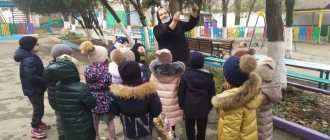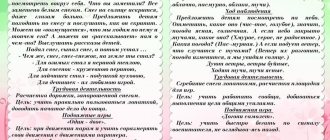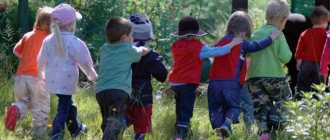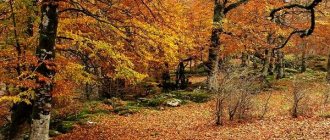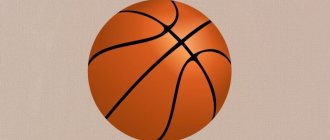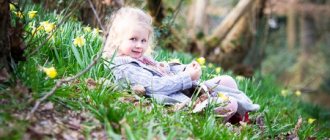Card index of walks in the middle group for the month of March
March Walk 1 Bird watching in the kindergarten area Objectives: - teach to recognize and distinguish birds by plumage, size, voice; - develop observation and memory; - cultivate a friendly attitude towards birds Literary word: In a gray fur coat, And in the cold he is a hero, Jumps, frolics in flight, Not an eagle, but still a bird. (Sparrow.) Color - grayish, Habit - furtive, Screamer hoarse - Famous person. (Crow.) She doesn’t sit still - She carries news on her tail. (Magpie.) March Walk 2 Observation of icicles Goals: - develop horizons, familiarize with natural phenomena - cultivate interest in spring observations Literary word: All the snowstorms have died down, and the frosts are no longer crackling, Drops are dripping from the roofs, and the icicles are standing in a row. Signs: If long icicles form on the roofs, spring will be protracted March Walk 3 Observation of pigeons Objectives: -to expand knowledge about the appearance of birds, their habits and habitat; -form real ideas about the life of birds. Literary word: We have known since ancient times that this bird is a postman. March Walk 4 Observation of poplar buds Objectives: -continue to get acquainted with the trees on the site; -form the idea that a bud is a house for a leaf. Literary word: There are flat lumps on the branches. Flat leaves lie dormant in them. The teacher asks the children a riddle. These small barrels will be unsealed by spring, while the leaves sleep in them and grow while they sleep. (Kidneys.) March Walk 5 Observation of the sky and clouds Objectives: - consolidate ideas about spring; - pay attention to the changes that have occurred in the sky; - develop the ability to see the beauty of the sky, creative imagination. Literary word: As a white swan swam across the sky from the north, A well-fed swan swam. Threw down in the fields of the lake, White fluff and feathers March Walk 6 Observation of the melting of snow Objectives: - teach to establish relationships in nature - continue to expand knowledge about the properties of snow, - lead to an understanding of the connection between the properties of snow and the state of the weather Literary word: Snow is now not the same one - It darkened in the field, The ice cracked on the lakes, As if it had been split. The clouds are moving faster, The sky has become higher The sparrow is chirping Having fun on the roof March Walk 7 Observing the spring sun Goals: - continue to teach children to notice and name the state of the weather; — clarify knowledge that in spring the sun shines brightly and begins to get hot; — learn to establish a cause-and-effect relationship: the sun is shining, it’s getting warmer. Literary word: Riddle: The snowball is melting and the meadow is coming to life, The day is coming - When does this happen? (In spring) March Walk 8 Observation of Drops Goals: - expand children's ideas about spring, enrich their knowledge with new words and concepts. Artistic word: Under the very cornice Above the very window The spring sun climbed into the icicles. Sparkling, tears run along the icicles... And the icicles melt - cheerful pieces of ice (I. Demyanov) March Walk 9 Observing spring changes in nature Objectives: - to teach to observe changes in the world around us with the arrival of spring; - develop the ability to see changes in the behavior of birds and plants; - cultivate interest in observing birds, plants and people. Artistic word: Riddle: It rings outside the window And sings “Spring has come! And the cold icicles turned into these streams!” Sunshine from the roof “Splash – Splash – Splash!” This is a small flood (Kapel) March Walk 10 Observation of the work of a janitor Objectives: - to develop a willingness to help, the ability to evaluate the results of work; — cultivate respect for working people; — develop speech, increase vocabulary (name and purpose of the janitor’s work equipment). Artistic word: Sunny bunnies playing on the ground. I will beckon them with my finger - Let them run to me. - Well, spring, how are you? - I have cleaning to do. - What do you need a broom for? — Sweep the snow from the hillock. -What do you need streams for? — Wash away the trash from the paths. -What do you need the rays for? - For cleaning too.
We recommend watching:
Spring fun for middle school children. Scenario: Meeting of Spring Integrated lesson for children of the middle group: Spring is red Synopsis of an integrated lesson in the middle group on the topic: Spring in the forest Synopsis of immediate educational activities in the middle group on the topic: Spring
Similar articles:
Walk observation in the older group. Early spring
Observing the sky and clouds in the senior group in spring
Walk “Migratory Birds”. Senior group. Spring
Observation “Trees and shrubs in spring.” Senior group
Walk “Observing a Dandelion” in the senior group
Winter walk for middle group children
Summary of the walk “Observing the winter sky” for children of the middle group
Author: Marina Viktorovna Vitskova, teacher of the MBDOU “Kindergarten “Goldfish” of the Astrakhan region, Chernoyarsk district. Description: using this material, children develop observation, curiosity, and attention. This material will be useful for parents and kindergarten teachers when conducting winter walks for middle school children. Objectives: to draw attention to the beauty of the winter sky; cultivate a love of nature; develop curiosity and creative imagination. Objectives: 1. Form ideas about winter, its signs and months. 2. Develop interest in phenomena occurring in nature. Equipment: shovels, buckets, Santa Claus mask.
Progress of the walk.
Educator. Children, now you and I will go for a walk. Do you want to take a walk? Children. Yes. (The teacher and children go out to the kindergarten area) Teacher. Guys, look how beautiful it is around! Reading a poem. Everything was covered with white snow: both trees and houses, a light-winged wind whistled: “Hello, Zimushka-winter!” An intricate trail winds along the lowland to the hill. It was the hare who printed: “Hello, Zimushka-winter!” They put up bird feeders again and pour food into them. And the birds sing in flocks: “Hello, Zimushka-winter!” Educator. It's a beautiful poem, isn't it, kids? Did you like it? Children. Yes very. Educator. Winter is a wonderful, beautiful time of year!
Children, guess the riddle. Mystery.
What kind of ceiling is this?
Sometimes he is low, sometimes he is tall, sometimes he is gray, sometimes he is whitish, sometimes he is a little bluish. And sometimes so beautiful, Lace and blue-blue! Children. Sky. Educator. Let's watch the sky today. Look at the sky. What do you see in the sky? Children. Clouds! Educator. What color are the clouds? What shape? (Children's answers) Educator. Lace of white beautiful clouds float across the sky. Guys, look carefully at the sky, it seems very high because of the purity of the frosty air. The frosty air is clean, you want to breathe it in again and again. Educator. Guys, what winter month is it now? Children. January. Educator. Name the signs about this month. Children. 1st child. January - frosts, February - snowstorms. 2nd child. 3rd child. January is a deaf time in the forest. 4th child. If January is cold, then July will be dry and hot; don’t expect mushrooms until late autumn. 5th child. There are no cold Januarys in a row. Educator. Guys, people call January Prosinets, because January days are filled with sun.
They say that the month was called “Prosinets” because the sun begins to shine more and daylight hours increase. Now you won’t be able to stay on the street for long, look how red your nose is! But the winter sun shines brightly in the clear blue sky. An outdoor game is played: “Frozen”.
Children choose Santa Claus with a counting rhyme.
Who's wearing a fur coat?
Who's wearing the hat? Who has a red nose? It's you - Santa Claus! After the words: - Santa Claus, Santa Claus! I brought a snowy woman! Baba, baba - snowwoman, run away, and whoever Santa Claus touches is “frozen” (leaves the game). Educator. Children, now let’s check how accurate and attentive you are. Individual work. Exercise children in throwing snowballs at a distance with their right and left hands. Educator. Guys, let's help our janitor? Labor activity. “To clear the paths of snow” Goal: to involve children in performing simple tasks. Game activity.
Outdoor game: “Snowflakes and the Wind”
Children gather in a circle and hold hands.
At a signal from an adult: “The wind blew strong, strong. Scatter, snowflakes! “—they run in different directions around the site, straighten their arms to the sides, sway, and spin. The adult says: “The wind has died down! Come back, snowflakes, to the circle.” Children run into a circle and hold hands. Summary of the walk. Educator. Children, did you enjoy your walk? Children. Yes, Educator. What did we do on our walk? What new did you learn? What else would you like to know? (Children's answers)
We recommend watching:
Reading competition on the theme Winter in kindergarten. Junior - middle group Scenario of winter physical education leisure for children of the middle group Scenario of winter physical education in the middle group “Games with a snowman” Scenario of physical education in the middle group on the topic: Winter
Similar articles:
Observation of the work of a janitor in winter in the middle group
Winter sports festival in kindergarten. Middle group
Morning exercises in the middle group. December
